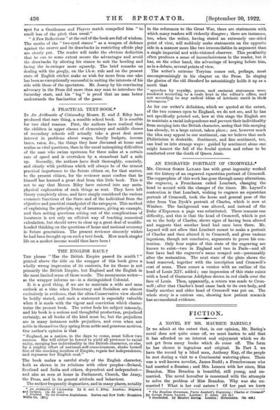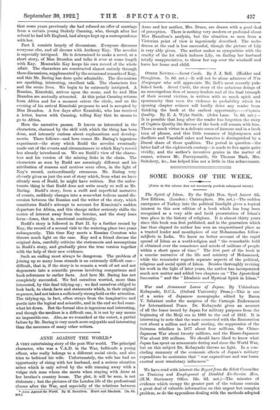FICTION.
A NOVEL BY MR. MAURICE BARING4 Ia we admit at the outset that, in our opinion, Mr. Baring's novel does not quite come off, we must hasten to add that it has afforded us an interest and enjoyment which we do not get from many books which do come off. The form he has chosen is ingenious and original. In Part L we have the record by a blind man, Anthony Kay, of the people he met during a visit to a Continental watering-place. There was a well-known novelist, James Rudd ; a Frenchwoman who had married a Russian ; and Mrs. Lennox with her niece, Miss Brandon. Miss Brandon is beautiful, still young, and un- married. The novel hereafter is concerned with the attempts to solve the problem of Miss Brandon. Why was she un- married? What is her real nature ? Of her past we learn • The Herallees Horseman, Pierre Lombart's Engraving : Charles or Cromwell? By George Somes Layard. London: P. Allan. K2 2s.] 1' Ovalooked, By Maurice Baring. London Heinemann. Its. net.]
that some years previously she had refused an offer of marriage from a certain young Stukely Canning, who, though after her refusal he had left England, had always kept up a correspondence with her.
Part L consists largely of discussions. Everyone discusses everyone else, and all discuss with Anthony Kay. The novelist is especially intrigued. He is determined to make a novel, or a short story, of Miss Brandon and talks it over at some length with Kay. Meanwhile Kay keeps his own record of the whole affair. The characters are constructed almost entirely through these discussions, supplemented by the occasional remarks of Kay, and this Mr. Baring has done quite admirably. The discussions are sparkling, interesting, excellent talk. The characters live and the scene lives. We begin to be extremely intrigued. A Russian, Kranitski, arrives upon the scene, and he and Miss Brandon are mutually attracted. At this point Canning returns from Africa and for a moment enters the circle, and on the evening of his arrival Kranitski proposes to and is accepted by Miss Brandon. A few days after Kranitski, who has received a letter, leaves with Canning, telling Kay that he means to go to Africa.
Here the narrative pauses. It leaves us interested in the characters, charmed by the skill with which the thing has been done, and intensely curious about explanations and develop- ments. There follows—and here comes Mr. Baring's ingenious experiment—the story which Rudd the novelist eventually made out of the events and circumstances to which Kay's record has already introduced us. We see Rudd's view of the charac- ters and his version of the missing links in the chain. The characters as seen by Rudd are amusingly different and his attribution of reasons and motives seem often, in the light of Kay's record, extraordinarily erroneous. Mr. Baring very cleverly gives us just the sort of story which, from what we have already seen of Rudd, he might have written. But the unfor- tunate thing is that Rudd does not write nearly so well as Mr. Baring. Rudd's story, from a swift and superficial narrative of events, suddenly changes into a somewhat tedious moral dis- cussion between the Russian and the writer of the story, which constitutes Rudd's attempt to account for Kranitski's sudden departure for Africa, and this change rather seriously shifts the centre of interest away from the heroine, and the story loses form—loses, that is, emotional continuity.
Rudd's story is followed in Part IL by a further record by Kay, the record of a second visit to the watering-place two years subsequently. This time Kay meets a Russian Countess who throws much light on the case. Kay and a friend discuss the original data, carefully criticize the statements and assumptions in Rudd's story, and gradually piece the true version together with the help of their new evidence.
Such an ending must always be dangerous. The problem of joining up so many loose strands is an extremely difficult one— difficult, that is, if the story is to remain a work of art and not degenerate into a scientific process involving comparisons and back-references to earlier facts. .And here Mr. Baring has not completely succeeded. We feel ourselves worried, more than interested, by this final tidying-up ; we find ourselves obliged to look back, to cheek facts and 'statements which, in their original sequence, had not taken a sufficiently strong hold on the attention. The tidying-up, in fact, often strays from the imaginative and poetic into the logical and scientific, and in the end we feel some- what let down. But the formal idea is ingenious and interesting, and though the medium is a difficult one, it is not by any means an impossible one. Also, as we remarked at the outset, a partial failure by Mr. Baring is very much more enjoyable and interesting than the successes of many other writers.



































 Previous page
Previous page